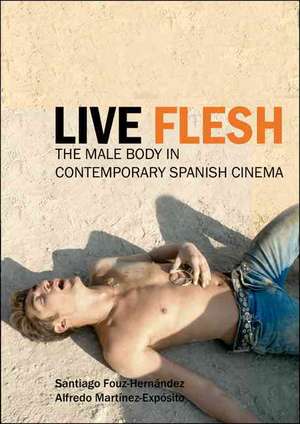Live Flesh: The Male Body in Contemporary Spanish Cinema
Autor Santiago Fouz-Hernandez, Alfredo Martinez-Expositoen Limba Engleză Paperback – 31 iul 2007
Live Flesh demonstrates how contemporary Spanish films have contributed to a re-shaping of the masculine image. The authors explore the complexity and diversity of these images, while focusing on Spanish films of the democratic period, both popular and auteur. The analysis is drawn from examples of directors, both of national and international prominence, such as Pedro Almodóvar, Alejandro Amenábar, Bigas Luna and Julio Medern, as well as films featuring acclaimed actors who have contributed to the construction of contemporary ideas of the masculine in their country, such as Antonio Banderas and Javier Bardem.Using a fresh theoretical framework, embracing queer and feminist theory and theories of nation, race and class, each chapter examines the key films that represent the male body (young, muscular, homosexual, foreign and so on), then focuses in on recent case studies, from the early 1980s to the present.
Preț: 167.97 lei
Nou
Puncte Express: 252
Preț estimativ în valută:
32.15€ • 33.44$ • 26.54£
32.15€ • 33.44$ • 26.54£
Carte disponibilă
Livrare economică 24 martie-07 aprilie
Preluare comenzi: 021 569.72.76
Specificații
ISBN-13: 9781845114503
ISBN-10: 1845114507
Pagini: 278
Dimensiuni: 161 x 232 x 21 mm
Greutate: 0.45 kg
Editura: I. B. Tauris & Company
Locul publicării:United Kingdom
ISBN-10: 1845114507
Pagini: 278
Dimensiuni: 161 x 232 x 21 mm
Greutate: 0.45 kg
Editura: I. B. Tauris & Company
Locul publicării:United Kingdom
Notă biografică
Santiago Fouz-Hernández teaches Spanish and Film Studies at the University of Durham. His publications include, as co-editor with Freya Jarman, Madonna's Drowned Worlds. Alfredo Martinez-Expósito is Reader in Spanish, University of Queensland. His books include, as editor, Gay and Lesbian Writing in the Hispanic World.
Recenzii
''One of [Live Flesh's] great strengths is the way that it builds upon the already habitually sharpened perspective of the emigre internalizing something of a second culture, and adds a strong commitment to seeking out the best and newest in the once home culture. The authors...enthusiastically identify a new, rapidly growing trend towards the formation of a distinctively Spanish style of theorizing visual culture, gender, sexuality, and the everyday and this often proves...interesting...The book is rich in its allusions to contemporary radical debate of this sort in Spain while maintaining a distinctive and original focus...''-- Hispanic Research Journal
